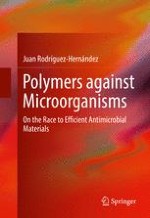2017 | OriginalPaper | Chapter
11. Applications and Current Status of Antimicrobial Polymers
Author : Juan Rodríguez-Hernández
Published in: Polymers against Microorganisms
Publisher: Springer International Publishing
Activate our intelligent search to find suitable subject content or patents.
Select sections of text to find matching patents with Artificial Intelligence. powered by
Select sections of text to find additional relevant content using AI-assisted search. powered by
